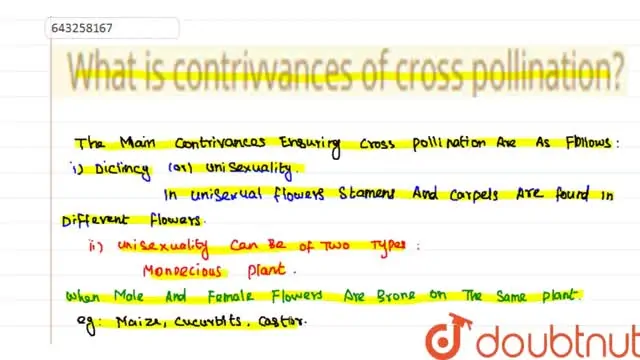What is contrivvances of cross pollination?Solution in Tamil
Contrivances of cross-pollination:
The flowers of the plants have mechanisms that promote cross-pollination which are also called contrivances of cross-pollination or out breeding devices. It includes the following.
1. Dicliny or Unisexuality:
When the flowers are unisexual only cross-pollination is possible. There are two types.
(i) Monoecious: Male and female flowers on the same plant. Coconut, Bitter gourd. In plants like castor and maize, autogamy is prevented but geitonogamy takes place.
(ii) Dioecious: Male and female flowers on different plants. Borassus, Carica papaya and date palm. Here both autogamy and geitonogamy are prevented.
2. Monocliny or Bisexuality:
Flowers are bisexual and the special adaptation of the flowers prevents self-pollination.
(ii) Dichogamy:
In bisexual flowers anthers and stigmas mature at different times, thus checking self-pollination. It is of two types.
(a) Protandry: The stamens mature earlier than the stigmas of the flowers. Example: Helianthus, Clerodendrum.
(b) Protogyny: The stigma mature earlier than the stamens of the flower. Example: Scrophularia nodosa and Aristolochia bracteata.
(ii) Herkogamy:
In bisexual flowers the essential organs, the stamens and stigmas, are arranged in such a way that self-pollination becomes impossible. For example in Gloriosa superba, the style is reflexed away from the stamens and in Hibiscus the stigmas project far above the stamens
(iii) Heterostyly: Some plants produce two or three different forms of flowers that are different in their length of stamens and style. Pollination will take place only between organs of the same length.
(a) Distyly: The plant produces two forms of flowers, Pin or long style, long stigmatic papillae, short stamens and small pollen grains, Thrum-eyed or short style,small stigmatic papillae, long stamens and large pollen grains. Example: Primula. The stigma of the Thrum-eyed flowers and the anther of the pin lie in same level to bring out pollination. Similarly the anther of Thrum-eyed and stigma of pin ones is found in same height. This helps in effective pollination.
(b) Tristyly: The plant produces three kinds of flowers, with respect to the length of the style and stamens. Here, the pollen from flowers of one type can pollinate only the other two types but not their own type.
Example: Lythrum.
(iv) Self sterility / Self-incompatibility:
In some plants, when the pollen grain of a flower reaches the stigma of the same, it is unable to germinate or prevented to germinate on its own stigma.
Example: Abutilon, Passiflora. It is a genetic mechanism.
Related Playlists
- BOOK - SURA PUBLICATIONCHAPTER - ASEXUAL AND SEXUAL REPRODUCTION IN PLANTSEXERCISE - Unit Test9videos
ASEXUAL AND SEXUAL REPRODUCTION IN PLANTS
- BOOK - SURA PUBLICATIONCHAPTER - ASEXUAL AND SEXUAL REPRODUCTION IN PLANTSEXERCISE - short answers52videos
ASEXUAL AND SEXUAL REPRODUCTION IN PLANTS
- BOOK - SURA PUBLICATIONCHAPTER - BREEDING AND BIOTECHNOLOGYEXERCISE - ADDITIONAL QUESTION & ANSWER (EXPAND THE FOLLOWING ABBREVIATIONS)7videos
BREEDING AND BIOTECHNOLOGY
Similar Questions
Choose the correct statements from the following.
03:38View SolutionWrite the advantages of natural vegetative reproduction.
02:47View SolutionExpand the abbereviation of "DNA" ?
03:00View Solutionपरागण किसे कहते हैं? यह कितने प्रकार का होता हैं? पर-परागण के लाभ बताइए ।
05:10View Solutionपर-परागण क्या है ? पर - परागण के दो लाभ लिखिए ।
05:51View Solutionपर-परागण क्या है ? पर-परागण के दो लाभ लिखिए।
03:15View SolutionWhat is cross pollination?
03:39View Solutionपरागण किसे कहते है। स्व- परागण एवं पर – परागण में अंतर लिखिए।
02:09View SolutionWhat is pollination? Explain self pollination and cross pollination with examples.
02:45View SolutionWhat is cross pollination ?
01:43View SolutionWhat is pollination? How is self-pollination different from cross pollination.
04:01View SolutionWhat are the advantages of cross pollination?
05:02View SolutionWhat is contrivvances of cross pollination?
03:19View Solutionफसल में पर-परागण को किस रूप में जाना जाता है?
02:20View SolutionWhat is the merits of cross pollination?
03:27View Solution


